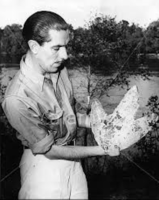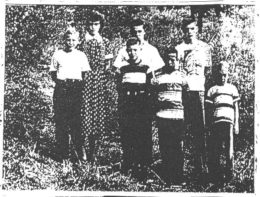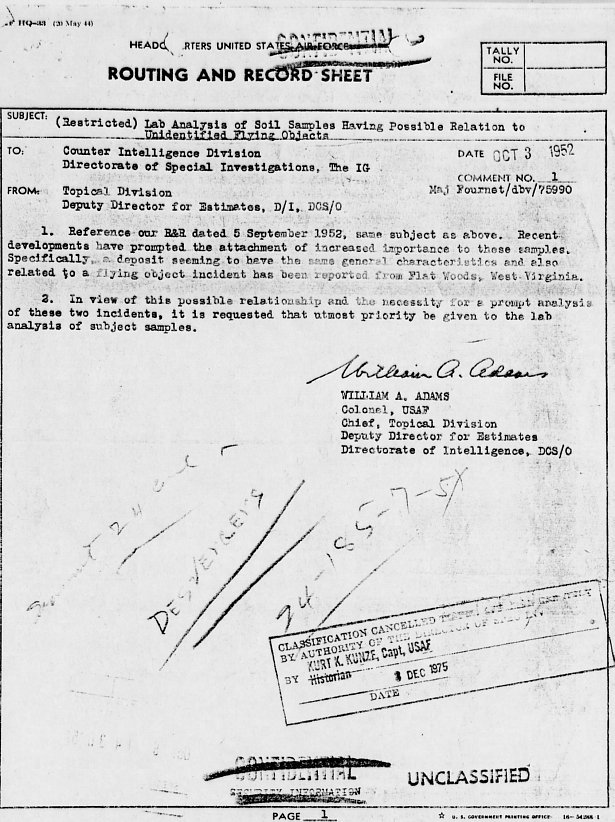by Charles Lear
 Much has been written about the 1952 Flatwoods Monster encounter in Braxton County, West Virginia. It is a bizarre tale that received national press coverage at the time and it is still celebrated today as part of West Virginia’s weird history. You can have your picture taken in one of five giant Flatwoods Monster chairs located in various areas around Braxton County and you can visit the Flatwoods Monster Museum in the town of Sutton. With all of the focus on the monster itself, certain aspects of the case tend to be overlooked. For one thing, this was the very first report of a creature associated with a U.F.O. For another, the case was looked into by some of UFOlogy’s very first private investigators.
Much has been written about the 1952 Flatwoods Monster encounter in Braxton County, West Virginia. It is a bizarre tale that received national press coverage at the time and it is still celebrated today as part of West Virginia’s weird history. You can have your picture taken in one of five giant Flatwoods Monster chairs located in various areas around Braxton County and you can visit the Flatwoods Monster Museum in the town of Sutton. With all of the focus on the monster itself, certain aspects of the case tend to be overlooked. For one thing, this was the very first report of a creature associated with a U.F.O. For another, the case was looked into by some of UFOlogy’s very first private investigators.
On Sept. 12, 1952, reports of fireballs flying through the air came into newspaper offices and police stations from all over the southeastern United States. Searches were made for the most likely suspects, downed planes and fallen meteors, and none were found. Then, in Braxton County, West Virginia, in the town of Flatwoods, a group consisting of six boys ranging in age from 10 to 17, were playing football in the fading hours of daylight. One of the younger boys caught sight of a fiery object in the sky and alerted the others.
They watched as it flew over them and then seemed to land in a nearby farmer’s field. They were eager to investigate and ran to the home of Kathleen May, mother to two of the boys, Eddie, 13, and Freddie, 12. The group of boys excitedly told her what they had seen and one of them, 17 year-old Eugene Lemon, found a flashlight. Mrs. May joined them as they went up the hill that led to the farm.
The following account comes mostly from one witness, 14 year-old Neil Nunley. According to Nunley, he and Lemon were ahead of the others. As they went up the hill, they saw a reddish, pulsating light. They passed through a gate in the fence around the field and dutifully closed it behind them. As they got closer, they encountered a fog that had a “pungent, irritating odor.” The fog became thicker as they approached the light. Nunley described the light saying, “It was just like a big ball of fire.” He said he couldn’t estimate the size of the light, but others described that it was “as big as a house.”
With their focus on the light, no one noticed a figure near the hilltop, fifteen feet to the left. Lemon then looked over and saw two spots of green light. Thinking they were animal eyes, he aimed the flashlight at them and revealed a tall humanoid figure.
The figure had a red face with two openings like eyes that projected beams of greenish-orange light over their heads. Around the face was a dark hood-like shape that came to a point like the ace of spades. Nunley described the body as being dark and colorless, but others said it was green. Mrs. May said she saw folds as if the body was draped in fabric. Most of the witnesses agreed that the body from the waist down was not clearly visible.
Whether or not the figure had arms was another area of disagreement. Mrs. May said she saw claws. Because the figure was under a limb that was 15 feet off the ground, its height was estimated to be around ten feet tall.
Lemon fell back with a scream as soon as he saw the figure. Nunley said it came toward them, but moved along an arc that would take it to the ball of light fifty feet down the hill. According to him, its movement was even and not like walking. As it moved toward the light, the witnesses fled. During their exit, their panic was such that no one bothered to open the gate. Mrs. May reportedly cleared it in a single leap.

The story made the local papers that Sunday and by Monday, the news was national. It caught the attention of Gray Barker, a man then living in nearby Clarksburg, West Virginia, who had been born and raised in Braxton County. Barker was a frustrated writer and science fiction fan who ran a theater booking agency. He contacted Ray Palmer, publisher of Fate magazine, and offered to investigate and write an article for the magazine. Palmer accepted his offer and gave him a deadline. The article was due the following Monday and Barker had only that weekend available to investigate.
When he went to Braxton County, Kathleen May and Eugene Lemon were in New York City. They had been invited to tell their story on the television show, “We the People.” The only witnesses available that first day were the remaining boys and Barker was able to interview them on tape. He was most impressed by Nunley whom he described as being “a very level-headed and unimaginative youngster.” He was able to interview Lemon and Mrs. May the following day.
The article was printed in the Jan. 1953 edition of Fate and marked the beginning of Barker’s life in flying saucers. He went on to become the chief investigator for the short-lived International Flying Saucer Bureau, founded his own publishing company and wrote several books on the subject. He was a colorful and controversial character who was less interested in solving the flying saucer mystery than he was in using it as a source of creative inspiration. He wrote about the Braxton County case in more detail in his classic 1956 book, “They Knew Too Much About Flying Saucers.”
While Barker was in Braxton County, he ran into another investigator, Ivan Sanderson, who was on assignment for True magazine and the North American Newspaper Alliance. Sanderson was a well-known, Cambridge educated naturalist who wrote books and articles on the subject. During his travels, he had developed an interest in creatures that were described in legend but were undocumented by science. He coined the phrase “cryptozoology” for this unique field of study. Sanderson had an interest in all things unusual and fit the profile of a Fortean. He and Barker would develop a lasting friendship. Both would also be regular guests on “The Long John Nebel Show”, which was the first radio show to feature discussions on the paranormal.
 Sanderson’s investigation was thorough and was described in the Sept. 12, 1954 Charleston, West Virginia Daily Mail. According to that account, he enlisted the aid of Earl Walter and Bert Ash, members of the Charleston chapter of the National Speleological Society. Together, they made an extensive survey of the area, interviewed five of the young witnesses repeatedly and found other area witnesses who had observed fireballs. Sanderson focused on the fireballs and determined that five objects had passed over the area, traveling from northwest to southeast. He issued a 26-page report that was carried by newspapers all over the country and, at least one in Britain. Sanderson was recorded describing his findings to John Nebel in 1953. During the interview, Sanderson described six objects and speculated that they were spaceships having trouble in a polluted atmosphere.
Sanderson’s investigation was thorough and was described in the Sept. 12, 1954 Charleston, West Virginia Daily Mail. According to that account, he enlisted the aid of Earl Walter and Bert Ash, members of the Charleston chapter of the National Speleological Society. Together, they made an extensive survey of the area, interviewed five of the young witnesses repeatedly and found other area witnesses who had observed fireballs. Sanderson focused on the fireballs and determined that five objects had passed over the area, traveling from northwest to southeast. He issued a 26-page report that was carried by newspapers all over the country and, at least one in Britain. Sanderson was recorded describing his findings to John Nebel in 1953. During the interview, Sanderson described six objects and speculated that they were spaceships having trouble in a polluted atmosphere.
 William and Donna Smith of Downey, California were on their way home when they stopped to investigate the story. Their findings were reported in the Civilian Saucer Investigators Winter 1953 Quarterly Bulletin #2. They added significant details not mentioned by Barker or Sanderson. According to their report, the “monster” emitted a mist that covered the May boys’ faces with an oily substance. Their throats later swelled to where they couldn’t swallow. Eugene Lemon was affected in a similar manner and still had pain two weeks later. Furthermore, Lemon’s mother reported that, at the time of “the landing” the house shook violently and the radio went off for 45 minutes and then came on again by itself. Finally, the Smiths located a 21 year-old woman who’d been confined in a Clarksburg hospital for three weeks after reporting a similar encounter with an odiferous “monster” a week before the Flatwoods incident.
William and Donna Smith of Downey, California were on their way home when they stopped to investigate the story. Their findings were reported in the Civilian Saucer Investigators Winter 1953 Quarterly Bulletin #2. They added significant details not mentioned by Barker or Sanderson. According to their report, the “monster” emitted a mist that covered the May boys’ faces with an oily substance. Their throats later swelled to where they couldn’t swallow. Eugene Lemon was affected in a similar manner and still had pain two weeks later. Furthermore, Lemon’s mother reported that, at the time of “the landing” the house shook violently and the radio went off for 45 minutes and then came on again by itself. Finally, the Smiths located a 21 year-old woman who’d been confined in a Clarksburg hospital for three weeks after reporting a similar encounter with an odiferous “monster” a week before the Flatwoods incident.
So, where was the Air Force during all this? Donald Keyhoe pondered that question in his 1953 book, “Flying Saucers From Outer Space.” He wrote that he spoke with Albert M. Chop of the Air Force Press Desk at the Pentagon. According to Chop, the Air Force had ignored the incident but Keyhoe later heard otherwise from other sources. According to them, Air Force Intelligence “worked through the West Virginia State police, securing all the details”, and followed up by sending two men who posed as magazine writers and interviewed witnesses.
The Project Blue Book file on the case contains news clippings but no record of the investigation. There is, however, an intriguing document that mentions soil samples from another case that had characteristics similar to those of soil from Flatwoods. It ends with the request that “the utmost priority be given to the lab analysis of subject samples.” It seems that, in this case, Blue Book went black.